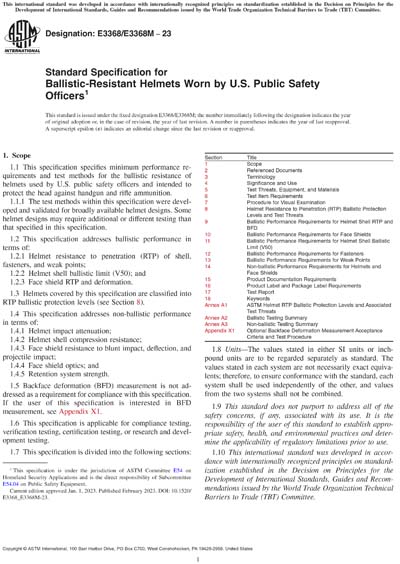Historical
ASTM E3368/E3368M-23
Standard Specification for Ballistic-Resistant Helmets Worn by U.S. Public Safety Officers
1.1This specification specifies minimum performance requirements and test methods for the ballistic resistance of helmets used by U.S. public safety officers and intended to protect the head against handgun and rifle ammunition.
1.1.1The test methods within this specification were developed and validated for broadly available helmet designs. Some helmet designs may require additional or different testing than that specified in this specification.
1.2This specification addresses ballistic performance in terms of:
1.2.1Helmet resistance to penetration (RTP) of shell, fasteners, and weak points;
1.2.2Helmet shell ballistic limit (V50); and
1.2.3Face shield RTP and deformation.
1.3Helmets covered by this specification are classified into RTP ballistic protection levels (see Section 8).
1.4This specification addresses non-ballistic performance in terms of:
1.4.1Helmet impact attenuation;
1.4.2Helmet shell compression resistance;
1.4.3Face shield resistance to blunt impact, deflection, and projectile impact;
1.4.4Face shield optics; and
1.4.5Retention system strength.
1.5Backface deformation (BFD) measurement is not addressed as a requirement for compliance with this specification. If the user of this specification is interested in BFD measurement, see Appendix X1.
1.6This specification is applicable for compliance testing, verification testing, certification testing, or research and development testing.
1.7This specification is divided into the following sections:
1.8Units - The values stated in either SI units or inch-pound units are to be regarded separately as standard. The values stated in each system are not necessarily exact equivalents; therefore, to ensure conformance with the standard, each system shall be used independently of the other, and values from the two systems shall not be combined.
1.9This standard does not purport to address all of the safety concerns, if any, associated with its use. It is the responsibility of the user of this standard to establish appropriate safety, health, and environmental practices and determine the applicability of regulatory limitations prior to use.
1.10This international standard was developed in accordance with internationally recognized principles on standardization established in the Decision on Principles for the Development of International Standards, Guides and Recommendations issued by the World Trade Organization Technical Barriers to Trade (TBT) Committee.
Content Provider
ASTM International [astm]






